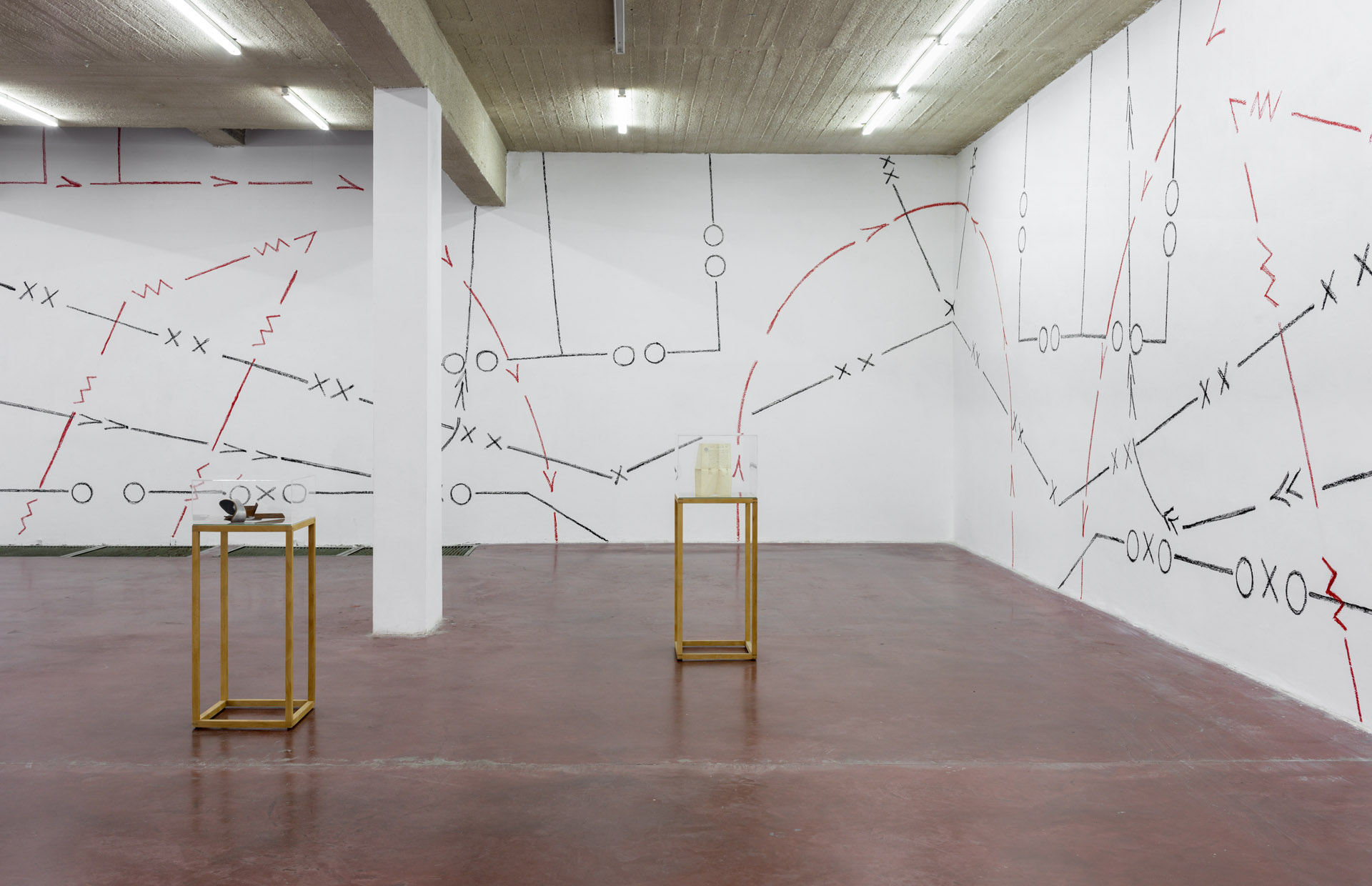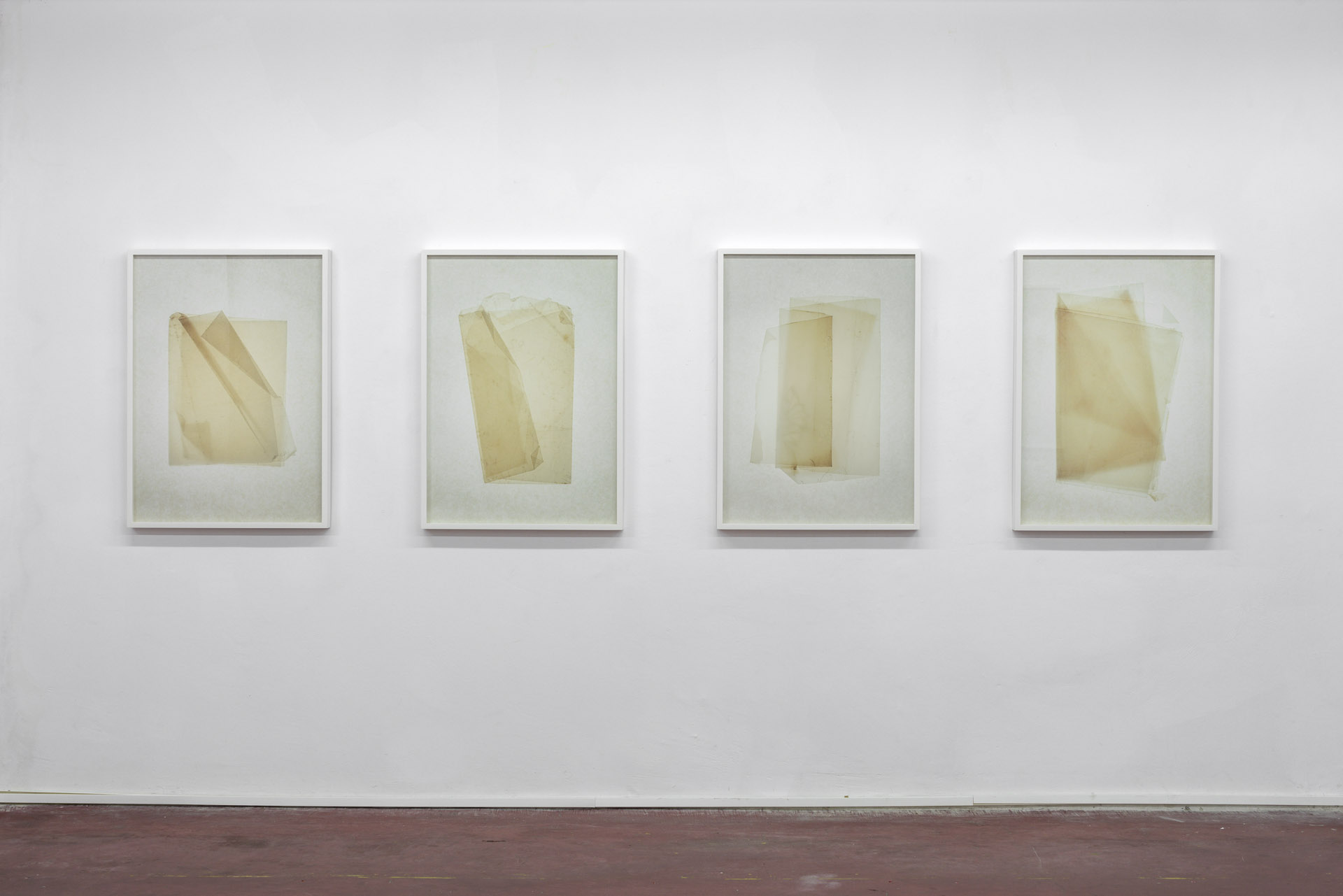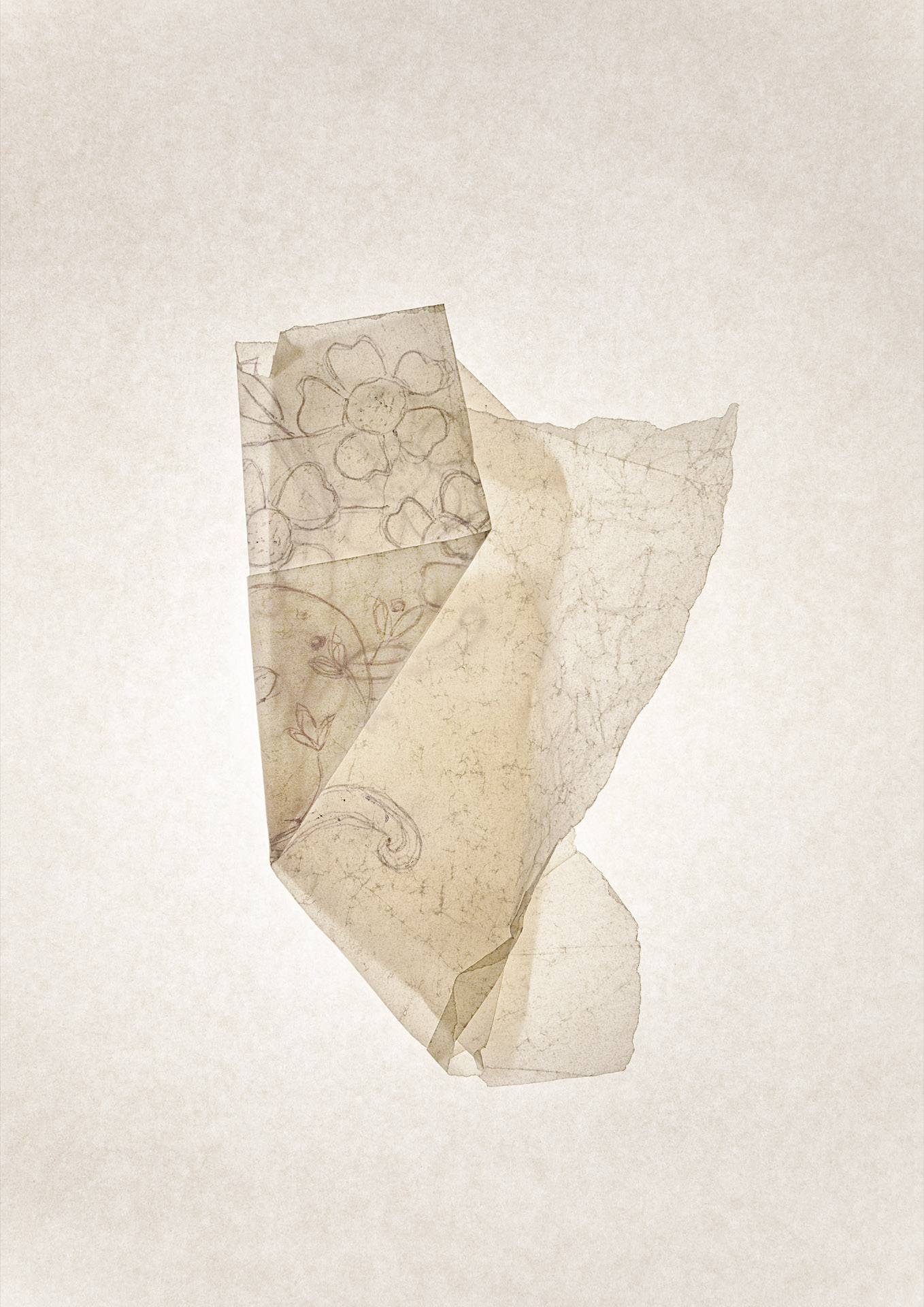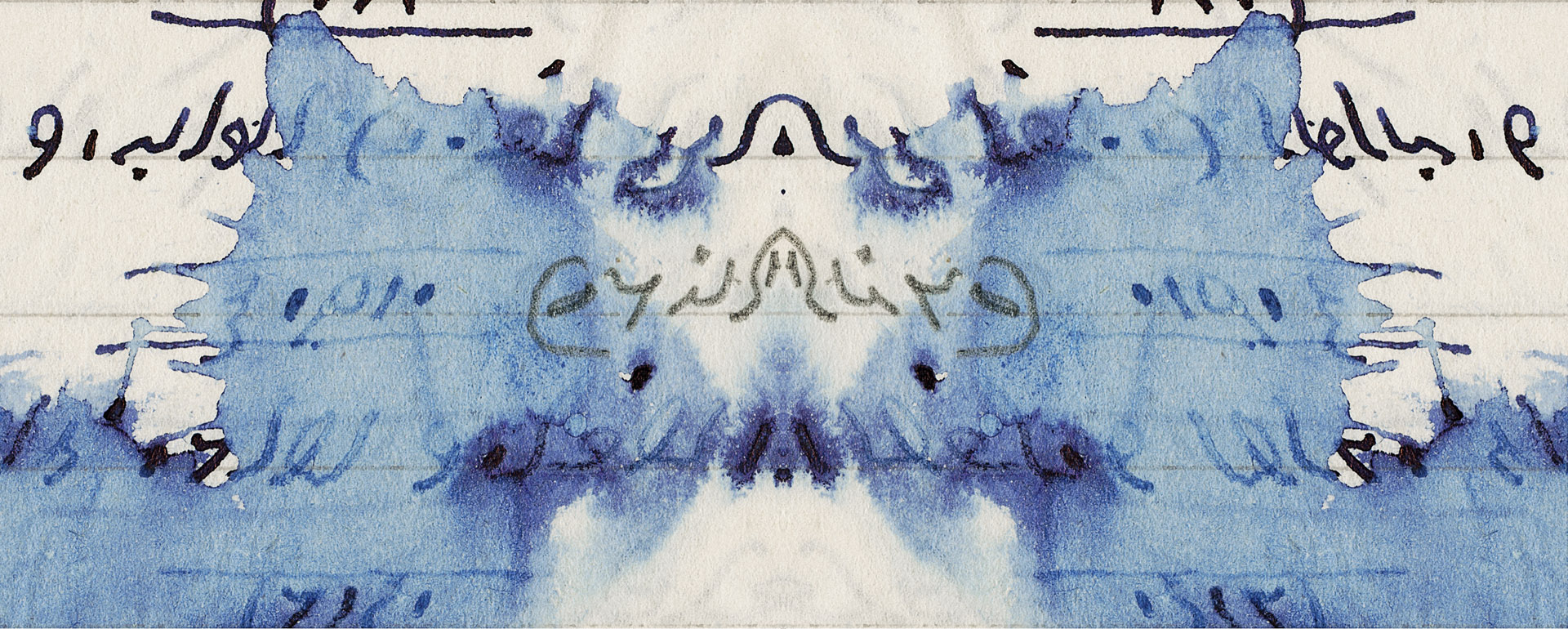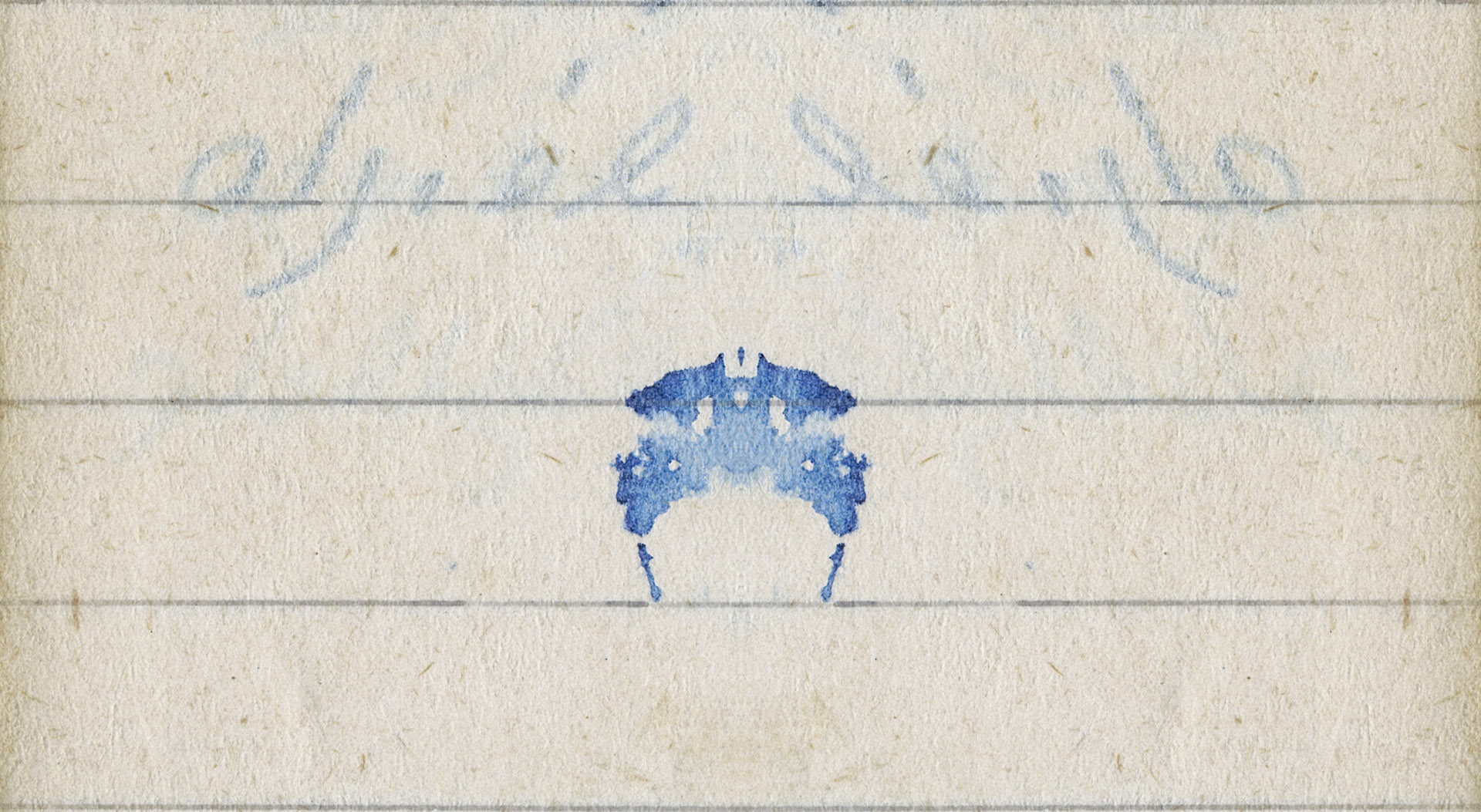Artist: Dor Guez
Exhibition title: Letters from the Greater Maghreb
Venue: Dvir Gallery, Tel Aviv, Israel
Date: September 4 – October 23, 2021
Photography: all images copyright and courtesy of the artist and Dvir Gallery
Dor Guez’s artistic practice is at once forensic and personal. It culminates in installations of found objects as well as deeply textured “scanograms,” a term he uses to describe a unique digital imaging process. Born into a blended family of Palestinians and Tunisian Jews, Guez explores chapters of his own layered history to expose the hidden connections, subversive undercurrents, and present-day contexts of his family’s unique story, and that of the region he comes from. Oftentimes the point of departure is a seemingly modest treasure from the family archive—a vintage wedding photograph, a dress-maker’s pattern, or a notebook written in an ancient Judeo-Arabic dialect. Yet for Guez such relics are the stuff of expansive possibility.
Guez’s work plays on the tension between what one inherits—a language, a name, a place of origin—and what one reinvents over time. Stories are told and retold, and traces of the past are rediscovered, shedding light on little-known facts and familial chapters. One recent work, Letters from the Greater Maghreb, reflects a pivotal moment in Guez’s family history, when his grandparents—who both worked in theater—escaped from concentration camps in Nazi-occupied Tunisia and later, in 1951, immigrated to Israel. The journey was arduous and key personal documents were damaged by water during the trip. One of these was a manuscript written by his grand-father in Judeo-Tunisian Arabic, using what looks like a mix of Hebrew and Arabic characters. Taking the fragile pages of the surviving document and creating enlarged scans of the single sheets and sections, Guez intensifies themes of blurring and loss in the resultant prints, at once bringing the viewer closer to and farther away from the meaning of the original words.
This visualization of disappearance evokes several cultural shifts simultaneously, particularly relating to language; Tunisian Jews adopted Hebrew as their language when they moved to Israel, and Judeo-Tunisian Arabic has begun to disappear. Duplication and fragmentation thus reify the immigrant’s experience of doubling and absence. Speaking of the visual devices at play in his work, Guez writes, “The words are engulfed in abstract spots and these become a metaphor for the harmonious conjunction between two Semitic languages, between one mother tongue and another, and between homeland and a new country.” Operating on multiple levels at once, Guez finds and resituates objects to reveal not only what from the past was lost but what has been largely forgotten or even consciously suppressed; the Nazi occupation of Tunisia, for example, is rarely addressed or publicly acknowledged. Yet his work allows these connections to emerge so poignantly because he cleaves so closely to the people whose lives they affected. In some instances his work quite literally fills negative space, as evidenced in his colorization and scanning techniques. He also uses light boxes to exaggerate overlooked relics, heightening their graphic presence. Adapting the clean, sterile casework of museum display, he puts personal objects on view, drawing attention not only to their intricacy and fragility but also to their powerful hybridity as displaced cultural artifacts and postwar readymades. It is in this unclassifiable realm—between the personal and the social, the found and fabricated, the seen and obscured—that Guez’s work gathers its force.
-Darsie Alexander
The Susan and Elihu Rose Chief Curator at the Jewish Museum New York
Text from the exhibition catalog: Afterlives: Recovering the Lost Stories of Looted Art
August 20, 2021 – January 9, 2022
Jewish Museum New York City
Published by Yale University Press
In addition to the two series of photographs displayed in the exhibition, Guez presents an insitu wall drawing, “Ligne à continuer” (The line continues), as well as two objects, displayed in vitrines. In one vitrine is a Jewish -Arab contract that Guez’s grandfather brought with him from Tunis, with a water stamp from 1934. The second vitrine presents a stereoscopic viewing device from the beginning of the twentieth century and a stereogram produced by Guez based on a 1937 hand-painted studio photo of Zina Guez, disguised as Queen Esther. The duplication of the studio photo creates a three-dimensional illusion when viewed through the dual lens. Similar to the series of photographs “Letters from the Great Maghreb”, and to the two objects displayed in the vitrines, the wall drawing also deals with mirror images. The mural, “Ligne à continuer” is based on Zina Guez’ original sewing pattern papers used by her to sew costumes for the theater, enlarged, it reassembles an oversized map spread on the gallery walls as an inverted image of the folded parchment papers standing on the other side of the space.
Dor Guez was born in Jerusalem and currently lives and works in Jaffa, he received his Ph.D. from Tel Aviv University in 2014 and earned his professorship from Bezalel Academy of the Arts and Design in 2018. To date, eight catalogues have been published internationally about Guez’s practice. Publishers include Distanz, New England Press, and A.M Qattan Foundation. Dor Guez’s work has been displayed in over thirty solo exhibitions worldwide, including the American Colony Archive, Jerusalem (2019), the Man Museum, Nuoro (2018); DEPO, Istanbul (2017); the Museum for Islamic Art, Jerusalem (2017); the Museum of Contemporary Art, Detroit (2016); the Institute of Contemporary Arts, London (2015); the Center for Contemporary Art, Tel Aviv (2015); the Rose Art Museum, Brandeis University, Massachusetts (2013); Artpace, San Antonio (2013); the Mosaic Rooms, Centre for Contemporary Arab Culture & Art, London (2013); the KW Institute for Contemporary Art, Berlin (2010); and Petach Tikva Museum of Art, (2009). He has participated in numerous group exhibitions, including shows at the Jewish Museum, NY (2021), the Israel Museum (2021), Susquehanna Art Museum (2019), Musée des beaux arts, Tourcoing (2018), New Zuzeum Art Center, Riga (2017), Arab World Institute, Paris (2017), the Buenos Aires Museum of Modern Art (2016); the North Coast Art Triennial, Denmark (2016); Weatherspoon Art Museum, Greensboro, North Carolina (2015); the 17th, 18th, and 19th International Contemporary Art Festival Videobrasil, São Paulo (2011, 2013, 2015); the 8th Berlin Biennale for Contemporary Art (2014); Cleveland Institute of Art (2014); Triennale Museum, Milan (2014); Centre of Contemporary Art, Torun (2014); Tokyo Metropolitan Museum of Photography (2014); Maxxi Museum, Rome (2013); Palais de Tokyo, Paris (2012); the 12th Istanbul Biennial (2011); and the Museum of Modern Art, Ljubljana (2010).
Guez’s works are part of numerous international public collections, including Tate Museum (London), Rose Art Museum (Boston), FRAC collection (Marseille), Israel Museum (Jerusalem), Schocken collection (Te Aviv), BNL collection (Italy), Petach Tikva Museum of Art (Petach Tikva), Brandis University (Waltham), Recanati collection (New York), Beit Hatfutsot (Tel Aviv), amongst others.
Dor Guez, Letters from the Greater Maghreb, 2021, exhibition view, Dvir Gallery, Tel Aviv
Dor Guez, Letters from the Greater Maghreb, 2021, exhibition view, Dvir Gallery, Tel Aviv
Dor Guez, Letters from the Greater Maghreb, 2021, exhibition view, Dvir Gallery, Tel Aviv
Dor Guez, Letters from the Greater Maghreb, 2021, exhibition view, Dvir Gallery, Tel Aviv
Dor Guez, Letters from the Greater Maghreb, 2021, exhibition view, Dvir Gallery, Tel Aviv
Dor Guez, Letters from the Greater Maghreb, 2021, exhibition view, Dvir Gallery, Tel Aviv
Dor Guez, Letters from the Greater Maghreb, 2021, exhibition view, Dvir Gallery, Tel Aviv
Dor Guez, Letters from the Greater Maghreb, 2021, exhibition view, Dvir Gallery, Tel Aviv
Dor Guez, Letters from the Greater Maghreb, 2021, exhibition view, Dvir Gallery, Tel Aviv
Dor Guez, Letters from the Greater Maghreb, 2021, exhibition view, Dvir Gallery, Tel Aviv
DOR GUEZ, Letters from the Greater Maghreb #2, 2021 archival inkjet print, 90 x 63.7 cm
DOR GUEZ, Letters from the Greater Maghreb #2, 2021 archival inkjet print, 90 x 63.7 cm
DOR GUEZ, Letters from the Greater Maghreb #2, 2021 archival inkjet print, 90 x 63.7 cm
DOR GUEZ, Letters from the Greater Maghreb #2, 2021 archival inkjet print, 90 x 63.7 cm
DOR GUEZ, Letters from the Greater Maghreb #2, 2021 archival inkjet print, 90 x 63.7 cm
DOR GUEZ, Letters from the Greater Maghreb #2, 2021 archival inkjet print, 90 x 63.7 cm
DOR GUEZ, Letters from the Greater Maghreb #2, 2021 archival inkjet print, 90 x 63.7 cm
DOR GUEZ, Letters from the Greater Maghreb #2, 2021 archival inkjet print, 90 x 63.7 cm
DOR GUEZ, Letters from the Greater Maghreb #1, 2021 archival inkjet print, 36 x 115 cm
DOR GUEZ, Letters from the Greater Maghreb #1, 2021 archival inkjet print, 36 x 109 cm
DOR GUEZ, Letters from the Greater Maghreb #1, 2021 archival inkjet print, 36 x 89.8 cm
DOR GUEZ, Letters from the Greater Maghreb #1, 2021 archival inkjet print, 36 x 65.6 cm
DOR GUEZ, Letters from the Greater Maghreb #1, 2021 archival inkjet print, 36 x 108.2 cm
DOR GUEZ, Letters from the Greater Maghreb #1, 2021 archival inkjet print, 36 x 45.4 cm
DOR GUEZ, Letters from the Greater Maghreb #1, 2021 archival inkjet print, 36 x 93.1 cm
DOR GUEZ, Letters from the Greater Maghreb #1, 2021 archival inkjet print, 36 x 110 cm
DOR GUEZ, Letters from the Greater Maghreb #1, 2021 archival inkjet print, 36 x 150.5 cm
DOR GUEZ, Letters from the Greater Maghreb #1, 2021 archival inkjet print, 36 x 123.7 cm




